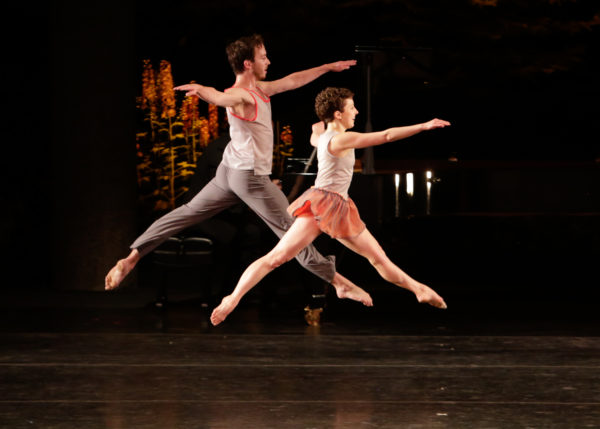Dance Preview: Dance Heginbotham’s “Common Fate” — Celebrating Synchronicity
By Susan B. Apel
Fresh from choreographing a Tony award-winning revival of Oklahoma!, John Heginbotham presents a world premiere in the Hopkins Center for the Arts at Dartmouth College.
Dance Heginbotham and Alarm Will Sound will perform on June 26 at 8 p.m. in the Moore Theater at the Hopkins Center for the Arts, Dartmouth College, Hanover, New Hampshire. Before the event, choreographer John Heginbotham and composer Tyondai Braxton will appear at the Top of the Hop at 6:30 p.m., talking about “The Uncommon Collaboration of Common Fate.”

Dance Heginbotham performance of “Easy Win” in 2015. Photo: Erin Baiano.
Oklahoma!, that staid staple of American musical theater, has been radically redrawn, garnering the 2019 Tony Award for Best Revival of a Musical. The scenery, including the meadow on which the “bright golden haze” has perennially hovered, was pared down. The lighting is bright and the house lights are up — the better to bring the surrounding audience into the action. Aunt Eller cooks cornbread during the performance, which is served with chili during intermission.
The most notorious element in the staging’s transformation — the one that left the tongues of critics and audience members wagging — may be John Heginbotham’s choreography of the “dream ballet,” a staple of the show’s staging since its 1943 Broadway premiere. Agnes de Mille fought for a then-revolutionary approach that brought Oklahoma’s main characters front and center, advancing the show’s narrative as Laurey dreamed about dealing with Curly and Jud. De Mille called the dance essential to “resetting” the tone of the second act.
Heginbotham kept the location of the dream sequence in the show, and he changed everything else. This reinvented dream is performed by a single dancer, Gabrielle Hamilton. According to the choreographer, it is “less cemented to the literal narrative of the show. It’s not trying to tell the story.” It is “really different in look and sound, although still in conversation with Agnes de Mille.” Hamilton’s interpretation of Laurey’s conflict is determinedly modern and edgy; the dancer performs wearing a glittering T-shirt with the words “Dream Baby Dream.” Reaction to the reinvention has been split: some view it as glorious, others as traitorous to the show’s tradition.

Alarm Will Sound in action. Photo: Michal Ramus.
Fresh from Oklahoma!’s Tony Award, Heginbotham is now staging the next of his many projects, this one in his role as director of his company Dance Heginbotham. He will be premiering the work, Common Fate, commissioned by the Hopkins Center for the Arts and nurtured by Heginbotham’s recent 2018 Guggenheim Fellowship. It is his contribution to the Hop’s annual, week long SHIFT Festival, which is designed to promote the values of collaboration by giving artists an opportunity to rub elbows with one another — as well as with audience members. The upcoming presentation combines the contributions of a trio of artists: Dance Heginbotham, Alarm Will Sound, a well-established group of twenty-two musicians devoted to avant-garde contemporary music, and composer Tyondai Braxton. Braxton’s compositions — either performed by the composer or by the likes of The Kronos Quartet and Philip Glass — have been played in top-drawer venues throughout the world.
The program at the Hopkins Center will contain three substantial pieces and two shorter pieces. The evening will run around an hour without an intermission. One of the shorter pieces, Fly by Wire, is an earlier collaboration between Braxton and Heginbotham. The dance, first performed in 2014 at the Metropolitan Museum of Art, is an energetic, playful piece that resonates with Heginbotham’s description of his new dance, Common Fate: “athletic, fast-moving, with traces of classical ballet and modern dance, and with a few idiosyncratic movements.”
The theme of this year’s SHIFT program focuses on our struggle to create a balanced relationship with nature. Given this topic, Common Fate is aptly titled. It is a term in Gestalt psychology which states that “humans perceive visual elements that move in the same speed and/or direction as parts of a single stimulus, such as a flock of birds.” Humans and nature have yet to achieve this splendid synchronicity. Dance Heginbotham, Alarm Will Sound, and Tyondai Braxton are drawing on their combined talents on June 26 to suggest the inspiring possibility.
Susan B. Apel is a writer and law professor whose creative nonfiction and poetry has appeared in Vine Leaves Literary Journal, Best of Vine Leaves 2015, Rhizomes, The Vignette Review, Woven Tale Press, Bloodroot, and the Fredericksburg Literary and Art Review. Her blog, ArtfulEdge, in which she writes about arts in the Upper Connecticut River Valley, appears regularly on the dailyUV.com. She is also a contributor to the newspaper, Vermont Woman. She lives in Lebanon, NH.
Tagged: Alarm Will Sound, Common Fate, Dance Heginbotham, Susan B. Apel
